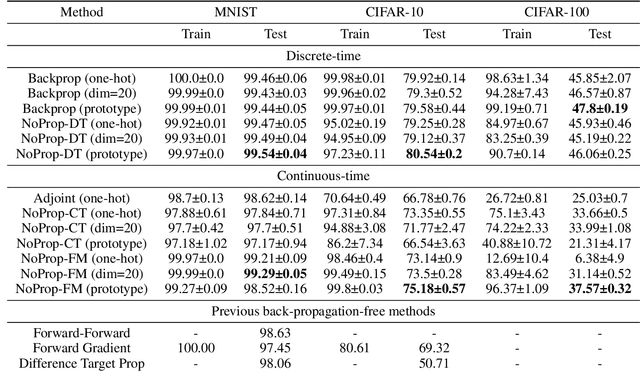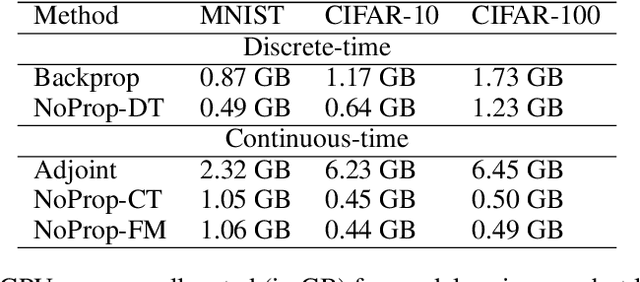Yee Whye Teh
University College London
Enhancing Large Language Model Reasoning with Reward Models: An Analytical Survey
Oct 02, 2025Abstract:Reward models (RMs) play a critical role in enhancing the reasoning performance of LLMs. For example, they can provide training signals to finetune LLMs during reinforcement learning (RL) and help select the best answer from multiple candidates during inference. In this paper, we provide a systematic introduction to RMs, along with a comprehensive survey of their applications in LLM reasoning. We first review fundamental concepts of RMs, including their architectures, training methodologies, and evaluation techniques. Then, we explore their key applications: (1) guiding generation and selecting optimal outputs during LLM inference, (2) facilitating data synthesis and iterative self-improvement for LLMs, and (3) providing training signals in RL-based finetuning. Finally, we address critical open questions regarding the selection, generalization, evaluation, and enhancement of RMs, based on existing research and our own empirical findings. Our analysis aims to provide actionable insights for the effective deployment and advancement of RMs for LLM reasoning.
Is Model Editing Built on Sand? Revealing Its Illusory Success and Fragile Foundation
Oct 01, 2025



Abstract:Large language models (LLMs) inevitably encode outdated or incorrect knowledge. Updating, deleting, and forgetting such knowledge is important for alignment, safety, and other issues. To address this issue, model editing has emerged as a promising paradigm: by precisely editing a small subset of parameters such that a specific fact is updated while preserving other knowledge. Despite its great success reported in previous papers, we find the apparent reliability of editing rests on a fragile foundation and the current literature is largely driven by illusory success. The fundamental goal of steering the model's output toward a target with minimal modification would encourage exploiting hidden shortcuts, rather than utilizing real semantics. This problem directly challenges the feasibility of the current model editing literature at its very foundation, as shortcuts are inherently at odds with robust knowledge integration. Coincidentally, this issue has long been obscured by evaluation frameworks that lack the design of negative examples. To uncover it, we systematically develop a suite of new evaluation methods. Strikingly, we find that state-of-the-art approaches collapse even under the simplest negation queries. Our empirical evidence shows that editing is likely to be based on shortcuts rather than full semantics, calling for an urgent reconsideration of the very basis of model editing before further advancements can be meaningfully pursued.
Rao-Blackwellised Reparameterisation Gradients
Jun 09, 2025Abstract:Latent Gaussian variables have been popularised in probabilistic machine learning. In turn, gradient estimators are the machinery that facilitates gradient-based optimisation for models with latent Gaussian variables. The reparameterisation trick is often used as the default estimator as it is simple to implement and yields low-variance gradients for variational inference. In this work, we propose the R2-G2 estimator as the Rao-Blackwellisation of the reparameterisation gradient estimator. Interestingly, we show that the local reparameterisation gradient estimator for Bayesian MLPs is an instance of the R2-G2 estimator and Rao-Blackwellisation. This lets us extend benefits of Rao-Blackwellised gradients to a suite of probabilistic models. We show that initial training with R2-G2 consistently yields better performance in models with multiple applications of the reparameterisation trick.
Extending Epistemic Uncertainty Beyond Parameters Would Assist in Designing Reliable LLMs
Jun 09, 2025Abstract:Although large language models (LLMs) are highly interactive and extendable, current approaches to ensure reliability in deployments remain mostly limited to rejecting outputs with high uncertainty in order to avoid misinformation. This conservative strategy reflects the current lack of tools to systematically distinguish and respond to different sources of uncertainty. In this paper, we advocate for the adoption of Bayesian Modeling of Experiments -- a framework that provides a coherent foundation to reason about uncertainty and clarify the reducibility of uncertainty -- for managing and proactively addressing uncertainty that arises in LLM deployments. This framework enables LLMs and their users to take contextually appropriate steps, such as requesting clarification, retrieving external information, or refining inputs. By supporting active resolution rather than passive avoidance, it opens the door to more reliable, transparent, and broadly applicable LLM systems, particularly in high-stakes, real-world settings.
NoProp: Training Neural Networks without Back-propagation or Forward-propagation
Mar 31, 2025



Abstract:The canonical deep learning approach for learning requires computing a gradient term at each layer by back-propagating the error signal from the output towards each learnable parameter. Given the stacked structure of neural networks, where each layer builds on the representation of the layer below, this approach leads to hierarchical representations. More abstract features live on the top layers of the model, while features on lower layers are expected to be less abstract. In contrast to this, we introduce a new learning method named NoProp, which does not rely on either forward or backwards propagation. Instead, NoProp takes inspiration from diffusion and flow matching methods, where each layer independently learns to denoise a noisy target. We believe this work takes a first step towards introducing a new family of gradient-free learning methods, that does not learn hierarchical representations -- at least not in the usual sense. NoProp needs to fix the representation at each layer beforehand to a noised version of the target, learning a local denoising process that can then be exploited at inference. We demonstrate the effectiveness of our method on MNIST, CIFAR-10, and CIFAR-100 image classification benchmarks. Our results show that NoProp is a viable learning algorithm which achieves superior accuracy, is easier to use and computationally more efficient compared to other existing back-propagation-free methods. By departing from the traditional gradient based learning paradigm, NoProp alters how credit assignment is done within the network, enabling more efficient distributed learning as well as potentially impacting other characteristics of the learning process.
Prompting Strategies for Enabling Large Language Models to Infer Causation from Correlation
Dec 18, 2024



Abstract:The reasoning abilities of Large Language Models (LLMs) are attracting increasing attention. In this work, we focus on causal reasoning and address the task of establishing causal relationships based on correlation information, a highly challenging problem on which several LLMs have shown poor performance. We introduce a prompting strategy for this problem that breaks the original task into fixed subquestions, with each subquestion corresponding to one step of a formal causal discovery algorithm, the PC algorithm. The proposed prompting strategy, PC-SubQ, guides the LLM to follow these algorithmic steps, by sequentially prompting it with one subquestion at a time, augmenting the next subquestion's prompt with the answer to the previous one(s). We evaluate our approach on an existing causal benchmark, Corr2Cause: our experiments indicate a performance improvement across five LLMs when comparing PC-SubQ to baseline prompting strategies. Results are robust to causal query perturbations, when modifying the variable names or paraphrasing the expressions.
Learning Loss Landscapes in Preference Optimization
Nov 10, 2024



Abstract:We present an empirical study investigating how specific properties of preference datasets, such as mixed-quality or noisy data, affect the performance of Preference Optimization (PO) algorithms. Our experiments, conducted in MuJoCo environments, reveal several scenarios where state-of-the-art PO methods experience significant drops in performance. To address this issue, we introduce a novel PO framework based on mirror descent, which can recover existing methods like Direct Preference Optimization (DPO) and Odds-Ratio Preference Optimization (ORPO) for specific choices of the mirror map. Within this framework, we employ evolutionary strategies to discover new loss functions capable of handling the identified problematic scenarios. These new loss functions lead to significant performance improvements over DPO and ORPO across several tasks. Additionally, we demonstrate the generalization capability of our approach by applying the discovered loss functions to fine-tuning large language models using mixed-quality data, where they outperform ORPO.
Non-Stationary Learning of Neural Networks with Automatic Soft Parameter Reset
Nov 06, 2024



Abstract:Neural networks are traditionally trained under the assumption that data come from a stationary distribution. However, settings which violate this assumption are becoming more popular; examples include supervised learning under distributional shifts, reinforcement learning, continual learning and non-stationary contextual bandits. In this work we introduce a novel learning approach that automatically models and adapts to non-stationarity, via an Ornstein-Uhlenbeck process with an adaptive drift parameter. The adaptive drift tends to draw the parameters towards the initialisation distribution, so the approach can be understood as a form of soft parameter reset. We show empirically that our approach performs well in non-stationary supervised and off-policy reinforcement learning settings.
L3Ms -- Lagrange Large Language Models
Oct 28, 2024Abstract:Supervised fine-tuning (SFT) and alignment of large language models (LLMs) are key steps in providing a good user experience. However, the concept of an appropriate alignment is inherently application-dependent, and current methods often rely on heuristic choices to drive the optimization. In this work, we formulate SFT and alignment as a constrained optimization problem, where the LLM is trained on a task while being required to meet application-specific requirements, without resorting to heuristics. To solve this, we propose Lagrange Large Language Models (L3Ms), which employ logarithmic barriers to enforce the constraints. This approach allows for the customization of L3Ms across diverse applications while avoiding heuristic-driven processes. We demonstrate experimentally the versatility and efficacy of L3Ms in achieving tailored alignments for various applications.
SymDiff: Equivariant Diffusion via Stochastic Symmetrisation
Oct 08, 2024



Abstract:We propose SymDiff, a novel method for constructing equivariant diffusion models using the recently introduced framework of stochastic symmetrisation. SymDiff resembles a learned data augmentation that is deployed at sampling time, and is lightweight, computationally efficient, and easy to implement on top of arbitrary off-the-shelf models. Notably, in contrast to previous work, SymDiff typically does not require any neural network components that are intrinsically equivariant, avoiding the need for complex parameterizations and the use of higher-order geometric features. Instead, our method can leverage highly scalable modern architectures as drop-in replacements for these more constrained alternatives. We show that this additional flexibility yields significant empirical benefit on $\mathrm{E}(3)$-equivariant molecular generation. To the best of our knowledge, this is the first application of symmetrisation to generative modelling, suggesting its potential in this domain more generally.
 Add to Chrome
Add to Chrome Add to Firefox
Add to Firefox Add to Edge
Add to Edge